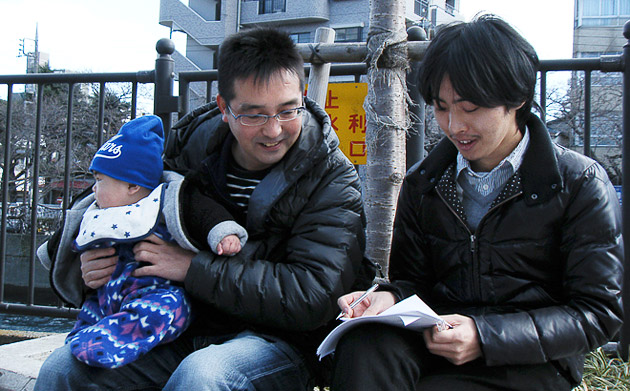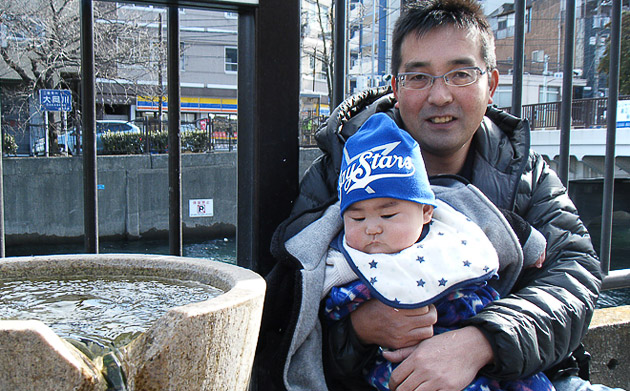Yuuichi Akiyama
-- Please tell us about where you were born and where you work now.
Yuuichi: I was born in Kawasaki, but I grew up in Aichi Prefecture. My parents lived in Yokohama and I ended up coming back here, too (Yokohama, which is near Kawasaki). As for work, I'm a company employee. I bought a house in Koganecho, and now live with my wife and new born son. It's already been about ten years since I moved...

-- So, you've been living in Koganecho since before the "Bye-Bye Operations?"
(Bye-Bye Operations denotes the city's efforts to clean up the prostitution problem in Koganecho.)
Yuuichi: Yes, when I moved here (around 2000), the adult entertainment district/red light district was still popular. But I heard it was even more so around the mid-1960s. Around the year 2000, for the most part it was still known as a red light district but in the 60s, on top of the brothels, there were Yakuza, drug dealers and the like lurking around in the background. I didn't actually see it but, you would hear stories about dead bodies floating in the river and stuff like that.
-- Why did you want to live here? Did you know the history of the area?
Yuuichi: Well, it was just convenient. Yokohama, Sakuragicho, Isezakicho--all those places are right around the corner. Yes, of course I knew about Koganecho's history, but I had also heard that were plans to clean up the area. At first, they were apparently aiming to clean everything up by the 2002 FIFA World Cup, but I guess it's taking a bit longer.
-- You began participating in the "Koganecho Bazaar" in 2008...what's the story behind that?
Yuuichi: After hearing that the area was going to be cleaned up and revitalized, I thought this is something I have to help with too. Since my own home is here in Koganecho, I couldn't just let that kind of place continue to exist, so I felt a strong sense of responsibility to lend a hand with the Bazaar. That's why I got involved.
-- Besides the Koganecho Bazaar, do you also participate in the town meetings or other city planning efforts?
Yuuichi: Yes, very actively.
-- Well, today there happens to be a "mochi-tsuki" event going on in Koganecho...
(mochi-tsuki is the traditional way to make mochi, or rice cakes. It is made my pounding steamed rice with a wooden mallet)
Yuuichi: Well, yeah, but to tell you the truth, there are fun things going on almost every day in other places nearby, too, like at Aka-Renga Soko (Yokohama's Red Brick Warehouse) and Minato-Mirai (the area around the port and Landmark tower). In other words, you don't really have to go out of your way to attend Koganecho's events in order to find something fun to do.
-- I see. But then what makes you want to participate so actively in Koganecho's special events, including today's Mochi-tsuki?
Yuuichi: Because as my own neighborhood gets nicer and nicer, I myself benefit from it, too. Not in the way businesses, for example, get more profits or money, but Koganecho gets better as a whole.

-- I want to ask you wife, Sayuri, as well: What was your impression of Koganecho when you first moved here?
Sayuri: Well, I moved here five years ago, so I got here after the Bye-bye Operations had cleaned up the red light district. Until that point, I had lived in Kouhoku Ward (a residential suburb of Yokohama), so right after moving to Koganecho I thought, "oh no, this place is really sketchy..." But after actually living here, I realized that that wasn't the case at all. Rather, it's a quite comfortable and convenient place to live. Koganecho is close to Minato-Mirai, The Red Brick Warehouse, and China Town. Even for shopping, I often go right over to Sakuragicho, Isezaki's shopping street, or Kannai (all of these areas have a variety of stores and are within a 10-15 minute walk from Koganecho). It sort of makes going to Yokohama Station (only about 3km away) feel like an outing!
-- Do you feel it's more convenient compared to living in Kouhoku Ward?
Sayuri: Yes, since everyone knows where Hinodecho is (laughs) (Compared to Kouhoku Ward). I mean, I've never heard anyone say "Where is that??" when I say I live in Hinodecho (the block next to Koganecho).
-- You said that you moved after the Bye-bye Operations、but was it easy becoming part of the community in Koganecho?
Sayuri: At that time I was working, so I actually didn't get to take part in most of the community activities. So, Yuuichi's built his relationship with the neighborhood entirely on his own. At the moment, I'm still on maternity leave, so I feel like I've finally been able to start getting to know the community. The people living in the apartments in front of our house are probably all in the same situation. It seems like everyone there has kids just like us, so I'm hoping that we can gradually start connecting with each other more.
-- As a couple raising children, in what direction would you like to see Koganecho take as it continues to change in the future?
Yuuichi: Now you can actually see kids out and about in the neighborhood, but a while ago, there's no way you would've seen kids running around like that. So, I would like to see Koganecho continue in that direction, where children can just walk around the town like any other "normal" place.
Sayuri: Yeah, I want Koganecho to be a safe place where you can raise your children. One thing that especially bothers me, is that there's still a lot of people who still walk around smoking cigarettes in the neighborhood (In Japan, it's often considered rude to smoke in areas outside of designated smoking spots). It's a really scary when I think about when our son learns to walk. Even though he could walk himself, I would have to still carry him around in my arms (to protect him from inhaling smoke).
-- What do you think should be done In order to continue the Koganecho area improvement efforts in a way that both newcomers and long-time residents can agree with?
Sayuri: Right now (in Japan), they've been setting up several centers that are a combination of senior citizen nursing homes and child care facilities. They're places where the older generation and young kids can interact with each other. So, I think it would be nice if Koganecho also set up a space like that where kids can play with older people, for example, underneath the railroad tracks. I first realized this after I began raising my own kids, but you can always count on the older people to try reach out to children. I'm sure there's a big difference between how our generation thinks about raising kids and how the older generation thinks, but I would feel very thankful if I could have my child spend even a little time with the older generation.
Yuuichi: The white-collar class has been gradually getting bigger here. And as they reach retirement age, those people end up with a lot of free time, but they usually end up spending all day in the house (laughs). Well, I guess independent business owners have to keep working as long as they're healthy, but anyway, I think it's definitely possible to have a place where those retired people and kids can interact with one another. Though, maybe that's something that's needed even more in the suburbs...
Data: 17.01.2011
Interview with Yuuichi Akiyama
Interviewed by Takahiro Masuzaki, Marina Hiratsuka
Data: 12.12.2010
Interview with Kikuko Hosoi
Interviewer: Takahiro Masuzaki
Data: 19.12.2010
Interview with Seigo Akitsu
Interviewed by Takahiro Masuzaki